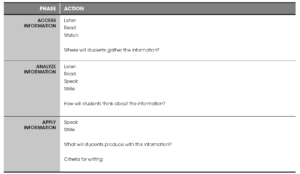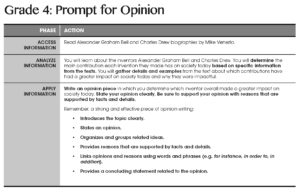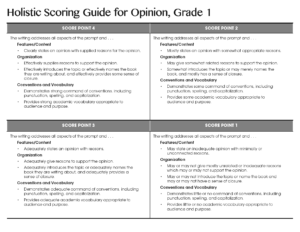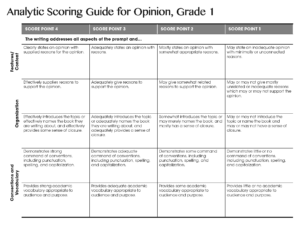Share this article.
The Common Core State Standards for English Language Arts and Literacy in History/Social Studies, Science, and Technical Subjects changed the game when it comes to literacy instruction. They set higher expectations for students to do more with texts. P. David Pearson describes their effect in this way,
“I think these standards have the potential to lead the parade in a different direction: toward taking as evidence of your reading ability not your score on a specific skill test–but the ability to use the information you gain from reading, the fruits of your labor, to apply to some new situation or problem or project.”
In other words, these standards are designed to be integrated so that students can gather information, think critically about that information, and produce their thinking around the information. The most efficient and effective way to help your students do this is by utilizing integrated literacy units that support students in being able to access information through listening and reading, analyze that information, and apply new learning through speaking and writing. That’s why in this series of articles, we’ve provided the support to understand the embedded patterns in the standards and the tools to analyze those patterns including the learning progressions, the skills within the standards, and the literacy correlations.
But there is one piece left to discuss. In order for students to be set up for success, it is critical that they have a clear roadmap for what they will be learning in the unit, how they will learn it, and how they will demonstrate their new learning. In an integrated unit that roadmap is a standards-based writing prompt and scoring guide which is the focus in this, our sixth and final, article in this series.
Why Writing Prompts and Scoring Guides Matter
Time and again, research bears out that students who know what they are learning and what success in that learning looks like are more likely to learn at a deeper level. John Hattie calls this approach “targeted learning.”
“There are two parts in targeted learning: the first is being clear about what is to be learned from the lesson(s) (the learning intention); the second is having a way of knowing that the desired learning has been achieved (the success criteria). Targeted learning involves the teacher knowing where he or she is going with the lesson and ensuring the students know where they are going. These pathways must be transparent for the student.” (Hattie, 2012)
In other words, a more targeted and sequenced approach leads to greater success. Because the culmination of the Access—Analyze—Apply framework for an integrated unit is a product of a student’s thinking, students will be more confident when they understand what they are expected to produce—the prompt—and what high quality looks like—the scoring guide. The purpose and value of the writing prompt and the scoring guides is that they bookend a successful integrated literacy unit.
What Makes a Writing Prompt Effective?
Just like there are three phases in the framework for an integrated literacy unit, Access—Analyze—Apply, so too are the same three pieces for a writing prompt to be effective.
Each piece of the writing prompt tightly aligns with and articulates to the student what is expected during the corresponding phase in the unit. When building a writing prompt, a teacher must think about, decide, and articulate the following details for their students.
Access Information
Students access information by listening, reading, and watching. Therefore, the teacher must determine what sources will students be accessing during the unit and answer the question: Where will students gather the information? These sources can be informational texts, literature, videos, podcasts, etc. There can be one source for the entire unit or multiple sources.
Analyze Information
Students analyze information by listening, speaking, reading, and writing. Therefore, the teacher must determine and articulate what students will be doing with the information they are accessing and answer the question: How will students think about the information? This is part of the writing prompt that will detail what students are learning and explicitly state skills from the standards that students will be using to gather and analyze the information.
Apply Information
Students apply their new learning about the information by speaking and writing. Therefore, the teacher must articulate what students will produce to demonstrate what they have learned. Teachers should answer the question: What will students produce with this information? and detail the criteria for writing. Their writing products can take a variety of formats, such as essay, research paper, speech, project, video, model, etc. This part of the writing prompt will come directly from the writing standards.
Take a look at these examples of effective writing prompts in Grades 1, 4, and 8.
What Makes a Scoring Guide Effective?
A scoring guide must clearly articulate the skills and expectations that will be assessed in each product from the integrated unit. It is critical that the writing prompt and scoring guide align in content and vocabulary which should come directly from the writing standards. There are two types of scoring guides that can be used:
- A holistic scoring guide that assesses the features/content, organization, and conventions and vocabulary of the writing as a whole. See the example from Grade 1.
- An analytic scoring guide that looks at and assesses each piece of the writing.
The Sequence of an Integrated Unit
Just like you begin every journey with your destination in mind and a map or plan for how to get there, so too should you begin an integrated unit with the end in mind. In other words, on the first day of an integrated unit, you should introduce, read, and discuss the writing prompt for that unit with your students. This will ensure that your students know what they will be learning, how they will learn it, and how they will demonstrate they have learned it.
As this video depicts, you will spend the remainder of the unit supporting your students as they work through the phases of Access—Analyze—Apply.
In the beginning, students will focus almost exclusively on gathering evidence, taking notes, and synthesizing until they reach the point when they are ready to write. It is important that they review the writing prompt to ensure they have the information they need before they proceed into the writing process where they draft, revise, and edit. When they are ready to publish, it is important they review the scoring guide to self-assess their product. They should recognize the parallel expectations of the scoring guide with the writing prompt and this should give them confidence that they have produced their best version of their learning.
Integrated Literacy Develops Learnership
The Common Core State Standards for English Language Arts and Literacy in History/Social Studies, Science, and Technical Subjects not only provide end-of-year expectations, but they also provide the framework to meet those expectations through integrated units and lessons and to support conceptual redundancy of the skills within the standards through an integrated scope and sequence that leads to mastery. And, it is this integration that makes literacy instruction effective because it supports students to gather information, think critically about that information, and produce their thinking around the information. That’s why the apex of the Access—Analyze—Apply framework for an integrated unit is a product of a student’s thinking. As Timothy Shanahan says,
“Writing about text was more powerful than just reading it or reading it and rereading it/studying it/discussing it.”
But more importantly, the notion of integrated literacy is rooted in the concept of student ownership. Students who own their learning are able to articulate their thinking to the following questions for each and every literacy lesson:
- Why am I learning this?
- What am I learning?
- How am I learning this?
- How am I showing I am learning it?
- How am I using this learning later?
- What is my role in the learning?
Teachers who have students who own their learning are able to leverage the embedded patterns to answer these questions both in their planning and in their literacy instruction. These teachers are not only developing literate citizens for the 21st Century, they are developing students with learnership.
Continue the Learning
Check out these articles and resources to continue your learning about this topic…
The Learning Brief
In this article you learned…
- It is critical that students have a clear roadmap for what they will be learning, how they will learn it, and how they will demonstrate their new learning. In an integrated literacy unit that roadmap is a standards-based writing prompt and scoring guide.
- Students will be more confident when they understand what they are expected to produce—the prompt—and what high quality looks like—the scoring guide.
- What makes an effective writing prompt, what makes an effective scoring guide, and the sequence of an integrated literacy unit.
Can you imagine building an environment full of motivated, engaged, and eager students who own their learning?
We can.







